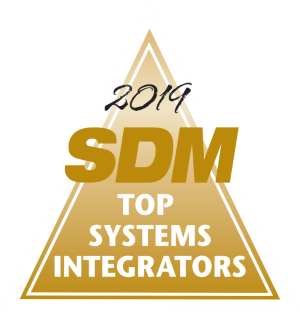The concept of the cloud has been around for about half a century. The first known use of the term in writing dates back to 1996, when a little-known company named NetCentric attempted to trademark “cloud computing.” Although many of us had used the cloud in some way or another (most notably email), it wasn’t until Google CEO Eric Schmidt used the phrase “cloud computing” to describe software as a service that the term — and concept — really began to pick up steam.
Over the last 10 years, awareness and usage of “the cloud” has grown ..and expanded tremendously in our everyday lives. And while the term can mean slightly different things to different people, we’ve reached the point where at least a majority of us have some notion of what the cloud is and how it can be used to simplify our lives.
There are myriad potential applications for cloud computing, which seem to be limited only by the imagination. In the security industry, these include video services, access control and more. While there was some initial hesitation about the cloud, mainly due to bandwidth and security concerns, improvements in video compression and more robust cybersecurity technologies and practices have allayed many of these concerns. Today, integrators and end users alike are embracing the concept in growing numbers, recognizing the benefits of collecting and storing video and other data and managing systems remotely.

Still, there are many end users who will assume that because video is stored off-site, that automatically means it is more susceptible to unauthorized access and greater risk. However, says Christian Morin, vice president of cloud services for Montreal-based Genetec, ensuring high levels of security and privacy has nothing to do with where the data is physically stored but more to do with having proper security mechanisms in place.
“Encrypted communications, data protection capabilities and strong user authentication and password protection are key features for any cloud-based system,” he says. “Also, many of the tier-one cloud providers have implemented far more stringent security measures for their infrastructures than private organizations because they actively want to earn trust by showing customers they have proper safeguards in place.”
Cloud-based video services — also known as video surveillance as a service (VSaaS) or video as a service (VaaS) — have particularly resonated with smaller and medium-sized businesses that are looking for the lowest total cost of ownership (TCO) and return on investment (ROI) from their video surveillance systems.
“VaaS is very popular for clients that have a limited install budget, need just a few cameras or have remote sites needing monitoring,” says Duane Richendollar, director of technology, vertical markets, Stanley Security, Indianapolis. “We tend to see that VaaS fits nicely for small- to medium-sized businesses — customers with four to six cameras and from one to many sites.”
Jennifer Graham, vice president of marketing, Kastle Systems, Falls Church, Va. (SDM’s 2015 Systems Integrator of the Year), says that while cloud video tends to be an easier sell for retrofitting existing installations, integrators shouldn’t lose sight of the importance of potential savings for end users with new systems. These savings can also benefit integrators’ bottom lines as well.
“The up-front cost to customers can be a lot lower than for a brand new system. Ongoing maintenance and upkeep are also easier,” she says. “Profit margins can vary by the level of service, but are higher for cloud-based video services than for on-premises solutions.”
In addition to potential cost savings, another factor that makes cloud video attractive is the peace of mind end users have from knowing that video will be available when and where it’s needed, especially for verifying or investigating an incident.
“With its remote accessibility it makes it easy for an owner or manager to keep an eye on business without having to be onsite all the time,” Richendollar says. “In addition, with the video being stored in the cloud, a thief can’t steal the video as with an on-site solution.”
For Kastle Systems, the cloud has actually reached a tipping point, according to Graham.
“Most of our customers are now opting for cloud-based video instead of on-premises VMS solutions,” she says. “Customers span most user segments that purchase video surveillance and CCTV systems.”
However, cloud-based video services are not limited to SMBs, with larger organizations and even some government entities recognizing the advantages of cloud-based video solutions as an attractive way to eliminate hardware and IT costs while reducing deployment and maintenance time and expense, Morin says.
“Some large organizations can no longer manage, host or scale massive private datacenters, and are looking for more cost-effective options,” he says. “For example, some large customers reach points where they outgrow their datacenter and the costs to maintain or expand their systems is no longer feasible. Governments are also implementing cloud-first policies where federal organizations must consider cloud-based options before building datacenters on premise.”
SHIFTING THE SALES MINDSET
Selling cloud-based video services, like any services, requires a different mindset than it takes to make equipment recommendations and purchases.
“Having knowledgeable salespeople makes a big difference; they can help the customer work through possible problems and set the proper expectations,” Richendollar says. “VaaS is not a good solution for continuous live video monitoring. If this is something the customer is looking for, an on-site solution may be better.”
The conversation gives integrators an opportunity to build an ongoing relationship with end users that includes ongoing support.
“Unlike server-based systems, which tend to be a one-time product sale, customers expect you to support them with VaaS services,” Graham says. “It’s important to have the support resources and train them well.”
In many cases, this shift in sales strategy and mindset has to encompass the entire organization, top to bottom.
“Changing your culture to a service-oriented culture is the key to success,” Graham says. “That spans the whole organization from sales to install/service and monitoring. This goes beyond ‘being there’ for the customer, and is a proactive approach that stays in tune with their needs, and operating and evolving their system as their needs change.”
For starters, integrators must be proactive in recommending appropriate cloud-enabled add-on services, rather than expecting end users to ask for them, says Chris Larcinese, regional marketing manager, Bosch Security Systems, Fairport, N.Y.
“Using the cloud to enable monitoring services is still quite new to end customers. Don’t expect them to ask you for it, but listen for clues [like a] desire for live video look-ins and professional 24/7 monitoring of a site; or difficult-to-secure environments or conditions using traditional sensors, such as car dealership lots or lobbies,” he says.
It’s also important to remember that with added services come additional costs, which play a key role in integrators’ offerings.
“Add-on services such as verification and remote video monitoring can add to monitoring costs in the central station. They are not the same as burglar alarms, and require more operator time, which should be considered when pricing these solutions,” Graham says.
“The cloud will enable integrators to focus on doing what they do best — becoming strategic advisors and partners to their customers — rather than getting bogged down in mundane details,” Morin says. “They must take the time to think of the role they will play in the relationship and the new and different ways they can provide value.”

Steve Van Till, CEO, Brivo, Bethesda, Md., says the best sales advice is to not overlook the opportunity to have a different kind of discussion with customers.
“We all get comfortable with things that are familiar to us; NVRs are certainly in that category. However, your customers have needs that remain unmet or underserved by the traditional on-premises recording approach,” he says. “Rather than just prescribing the typical NVR, discover your customers’ unmet needs for mobility, broad access to video data and the assured recording delivered by cloud-based video.”
The payoff from an educated and focused sales process can be significant in the form of additional RMR generated from add-on services made possible with the cloud.
“Integrators can increase RMR opportunities with an integrated hardware and software platform that meets their customers’ video requirements by offering wired and wireless cameras, static and motion cameras, and doorbell cameras with local storage combined with video cloud storage in a single installation,” says Ilan Dee, director of product marketing, cloud services at Honeywell Security and Fire, Melville, N.Y.
One way integrators can seize on this opportunity is by offering bundled services as a package for a low monthly fee — recognizing, of course that they’ll need to have some skin in the game when staring out, Morin says.
“This will require some upfront financing for the hardware, which should take approximately one to two years to recoup, but will continue to bring in revenues past that point,” he says. “Granted, there will have to be some adjustments made internally to determine how this new pricing model can fit within their existing sales objectives and compensation plans, as this shift will inevitably affect this. But the sooner integrators can figure it, the sooner they will start to reap the benefits.”
CHOOSING A PARTNER/PROVIDER
Very few systems integrators have the knowledge, capability or budget to deploy the infrastructure needed to offer cloud-based services directly. Instead, most work with a partner who can host customers’ video. So before you can even think about offering and selling cloud-based video services, you need to find the right cloud partner — a process that involves several considerations to ensure end users will be both comfortable moving video to the cloud and happy with the service offering.
“There are several things to consider,” Richendollar says. “How long has the partner been offering this service, and what experience do they have doing this? What type of data center is it located in — tier 1, 2, 3 or 4? Does the data center have the appropriate certifications, such as SAS 70 SSAE 16? What type of connection do they have to the Internet, and is there any redundancy for both the internet and the hardware? And finally, how fast can they expand the system?”
In fact, security is likely the most important aspect to evaluate. Rather than take spec sheets and claims at face value, Graham says, integrators should look for a vendor who offers a “try it before you buy it” program.
“There is rightfully a lot of concern with moving video to the cloud,” she says. “It is important to make sure that the cloud video partner has a track record of high availability and network security. There are a lot of claims in the market, so it is important to stress test a solution for a few weeks with active usage before committing to a vendor.”
Pricing is also key in the evaluation process, as cloud video backup is an important aspect of VSaaS offerings, Graham adds.
“Many vendors offer low-resolution backup and upsell additional storage options or charge for overages,” she says. “It is important to compare solutions and avoid surprises if you go over quota. Work with a vendor that will provide unlimited or flat pricing plans.”
The key to working with cloud-based video services is simple: embrace — don’t fear — the cloud.
“Don’t be afraid of the cloud,” Larcinese says. “Its scalability and accessibility make it a very valuable tool for connectivity to remote devices. However, make sure your provider’s cloud infrastructure is robust and redundant, not simply a self-managed server.”
The inevitable growth of the cloud and its increasing importance to the video surveillance picture make this a good time for integrators to seize on this model.
“The cloud represents a major and completely unavoidable shift in the security industry and integrators who want to capitalize on this tremendous opportunity need to start building that portfolio now, or they will get left behind,” Morin says.
Bandwidth
In what has become a familiar refrain to anyone working with video surveillance, available bandwidth can make or break an installation. This is especially true of cloud-based video, which requires uploading video to off-site servers. Customers who don’t have enough bandwidth to handle the amount of video they want to move to the cloud may be the biggest issue with the cloud at the moment, says Duane Richendollar of Stanley Security Services.

“This can cause repeat visits to troubleshoot, resulting in dissatisfied customers,” he says. “Having someone with the knowledge to analyze the existing network — and its ability to handle the additional data from the cameras — is critical. Just because a customer has a big Internet pipe does not mean that it is all available for the video to use.”
The main advice Charlie Erickson, executive vice president of product management, 3xLogic, Westminster, Colo., offers integrators is to remember that moving all video to the cloud requires a dedicated bitrate for each camera, but the bandwidth required may be expensive or not even available at some locations.
In these cases, he adds, automated exception — or incident-based video recording — makes a lot of sense, allowing video to be moved off-site to be viewed quickly when needed.
“(The video) can be moved at the speed the network link to the cloud supports,” Erickson says. “Most people have fast access to the cloud from corporate locations, home or mobile devices.”
In addition to customers who may lack the appropriate bandwidth to handle the video data load, cloud storage services can also create challenges, says Matt Sailor, CEO, IC Realtime, Pompano Beach, Fla.
“Many cloud storage facilities limit the resolution that can be stored; most are 1080p,” he says. “This means if the customer has, say, five, eight or 10 megapixel cameras, they’re wasting a lot of money because that resolution will not be stored at what the camera is capable of serving.”
While it is true that there are still locations where access to high-speed Internet connectivity may be too expensive to stream video to the cloud, luckily this is rapidly becoming the exception, says Genetec’s Christian Morin.
“The increasing availability of faster and more affordable Internet connectivity is becoming pervasive and rarely, if ever, will affect a business’ ability to leverage cloud services,” he says.
MORE ONLINE
To read more about Cloud-Based Video,
visit SDM’s website, where you will find
the following articles:
“Feeding the Growing Appetite for RMR Video Services”
www.SDMmag.com/the-growing-appetite-for-rmr-video-services
“Recording Technologies Give RMR a Boost”
www.SDMmag.com/recording-technologies-give-rmr-a-boost
“ROI Reinvented: The New Business Models for All Things Security”
www.SDMmag.com/roi-reinvented
“The Continuing Evolution of the Cloud”
www.SDMmag.com/continuing-evolution-of-the-cloud
“5 Questions Integrators Should ask About Video Storage”
www.SDMmag.com/questions-about-video-storage
“An Integrator’s Guide to Pricing and Selling Cloud Video Storage”
www.SDMmag.com/guide-to-pricing-and-selling-cloud-video-storage










